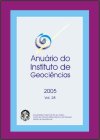Acritarchs and prasinophytes from Amazonas Silurian basin: a good tool for the Trombetas Group biostratigraphic calibration
DOI:
https://doi.org/10.11137/2005_1_131-142Abstract
This paper deals with borehole data from 1.587,80-1.660,75 m interval of the well 1-AM-1-AM, which represents the most complete section of the Silurian in Amazon basin. Pitinga and Lower Manacupuru formations occurring in Petrobras cores T-40 to T-47 and in Eletronorte shallow boreholes SM 1015, SM 1016, SM-1018, SM-1047 and SM 10-48 were analysed. Besides Acritarch, Chitinozoa, Criptospores, Escolecodontia and amorphous organic matter were also recorded. The Silurian section is rich in well-preserved Acritarchs and prasinophytes, exhibiting a great diversity, mainly in the Pitinga Formation. Forty and eight species were classified. For each well, the Acritarch vertical distribution was done, the asociations age was discussed and the Chitinozoa-based dating, as established by (Grahn and Melo 1990), was compared. The informal division of the Pitinga Formation in lower and upper members was kept. The lower member (Telychian to Sheinwoodian) is represented mainly by Domasia limaciforme, D. Canadensis, D. trispinosa, D. amphora, D. rochesterensis, Dateriocradus monterrosae e Salopidium granuliferum, Cymbosphaeridium pilar, Dactylofusa tenuistriata, D. cucurbita, Deunffia furcata, Baltisphaeridium capillatum, Vibysphaera erratica, Micrhystridium intonsurans. The upper member (Gorstian) is separated from the lower by a hiatus, and is well defined by the following species: Deunffia furcata, D. brevispinosa, D. ramusculosa, Tyrannus giganteus, Eisenackidium ramiformis, Gorgonisphaeridium bringewoodense, Domasia bispinosa, D. trispinosa, Helios aranaides, Micrhystridium stellatum, Neoveryhachium carminae, Multiplicisphaeridium caperoradiola, Leiofusa kryanovii, Leiofusa filifera, Oppilatala insolita, Pterospermopsis marysae, Veryhachium rhomboidium, Cymbosphaeridium pilar, Cymbosphaeridium cf. ravum, Multiplicisphaeridium fisheri, Dactylofusa striatifera, Polysphaeritae, Visbysphaera microspinosa, Visbysphaera dilatispinosa, Salopidium wenlockensis and Veryhachium europaeum. According to Molyneux et al., 1996, most of the referred species such as Tyrannus giganteus and Perforela perforata are indigenous forms that were described in Upper Silurian from Spain and North Africa. Although these species could be excellent biostratigraphic markers, some of them still need a graptolitic correlation. For the basal Manacupuru formation, separated from Pitinga formation by a hiatus, the following species could be noted: Balthisphaeridium pilar, B. cariniosum, Multipliscisphaeridum saharicum, M. scaber, Domasia rochesterensis, Dateriocradus monterrosae, Neoveryhachium carminae and Perforela perorata. This association is considered to be Pridoli in age, which agrees with the Chitinozoa-based dating of Grahn & Melo (1990). Deunffia and Domasia are important taxa defining the Llandovery-Wenlock interval, of incontestable chronostratigraphic value, since they are restricted globally to the Silurian. According to (Cramer, 1970a; Le Hérissé, 1989; Molyneux et al., 1996) these taxa increase in number near the boundary between Llandovery-Wenlock, what is also confirmed in the present paper.Downloads
Published
2005-06-01
Issue
Section
Article
License
This journal is licensed under a Creative Commons — Attribution 4.0 International — CC BY 4.0, which permits use, distribution and reproduction in any medium, provided the original work is properly cited.

















